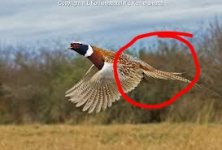Michealdavis
New member
Went out yesterday and chased up 4 roosters 3 were maybe 40 yards out which I did not shoot at. 1 was flying directly towards me and I missed it. So my question is how far away will you shoot birds and what shot will you use. The reason I did not shoot the ones 40 yards away was because on opener we shot a couple birds within 20 yards and the dog brought them back alive. We were using #4 shot





